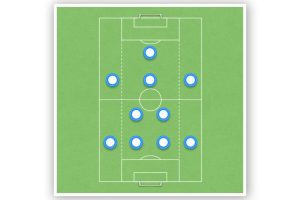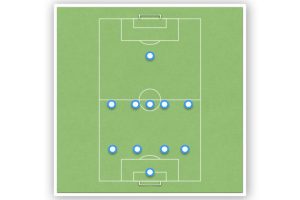Sean Dyche – Key principles of the 4-4-2 formation and how he used it at Burnley
This article is based on one of my favorite videos on YouTube.
Sean Dyche shares his perspective on the 4-4-2 formation and how it is used at Burnley Football Club. They discuss the defensive strategy of the formation, including how to deal with different opponent formations and how to defend against top sides. The article also covers offensive strategy in the 4-4-2 formation.
Key Takeaways
- The 4-4-2 formation is used at Burnley Football Club and is based on simple lines of movement.
- The defensive strategy in the 4-4-2 formation focuses on locking down one side of the pitch and using cover space and distance.
- The offensive strategy in the 4-4-2 formation involves playing out quickly and changing the split of the team to create opportunities.
Understanding the 4-4-2 Formation
The 4-4-2 formation is a classic formation that has been used for many years in football. This formation is based on having four defenders, four midfielders, and two forwards. It is a simple formation that is easy for players to understand and follow.
The basic principle of the 4-4-2 formation is to keep the team compact and organized. The defenders are responsible for defending the goal, while the midfielders are responsible for controlling the midfield. The forwards are responsible for scoring goals.
Contrary to popular belief, the 4-4-2 formation is still effective in modern football. While other formations like 4-3-3 and 3-5-2 have gained popularity in recent years, the 4-4-2 formation has been around for decades and has proven to be successful.
One of the benefits of the 4-4-2 formation is that it provides a clear structure for the players to follow. The lines of movement are simple and easy to understand. This makes it easier for the players to work together and coordinate their movements on the pitch.
In terms of defensive structure, the 4-4-2 formation emphasizes cover space and cover distance. This means that the players are not always marking man to man, but are instead responsible for covering certain areas of the pitch. This allows the team to stay compact and prevent the opposition from finding gaps in the defense.
When the team has possession of the ball, the 4-4-2 formation allows for quick counterattacks. The forwards are positioned to receive long balls from the defense, and the midfielders can quickly move the ball up the pitch to create scoring opportunities.
Overall, the 4-4-2 formation is a classic formation that is still effective in modern football. Its simplicity and clear structure make it easy for players to understand and follow, while its emphasis on cover space and cover distance helps the team stay organized and compact.
Defensive Strategy in 4-4-2
The Burnley football club’s defensive strategy in a 4-4-2 formation is designed to keep the opposition on one side of the pitch and lock them in, preventing them from shifting and opening up space. The team aims to be brave from start points, such as goal kicks, and drop their midfield to deal with the opposition’s midfield.
The basic principle of the 4-4-2 formation is to keep one side of the pitch and lock the opposition on that side. The team’s center forward drops around the opposition’s playmaker to prevent them from playing through the middle. The midfield works to keep the opposition’s play on one side of the pitch and lock them in.
The team’s defensive strategy is to be compact and leave one center forward up the pitch for an out. The team works hard to shut down the opposition’s clever play and lock off the V. The wide players and fullbacks come and tag team to prevent the opposition from creating chances.

Once the team gets into the final third, they work to crowd out the key scoring zone and safeguard the position. The team’s defensive structure is in place, and they use cover space and cover distance to defend. The team uses man for man marking when necessary and works to use the 4-4-2 formation wisely.
When the team gains possession of the ball, they aim to play out quickly and change the point of attack. The team talks a lot about changing the point of attack and playing out quickly from the back to catch the opposition off guard.
Overall, the Burnley football club’s defensive strategy in a 4-4-2 formation is designed to be compact, lock the opposition on one side of the pitch, and prevent them from creating chances. The team aims to be brave from start points and use cover space and cover distance to defend.
Dealing with Different Opponent Formations
The Burnley football club has a clear defensive structure in place that revolves around the 4-4-2 formation. However, the opponents’ formations can vary, and the team needs to adapt accordingly. The manager emphasizes the importance of being brave and locking on to the opponents regardless of their formation.
When playing against a 4-3-3 formation, Burnley’s midfield drops to deal with the opponent’s midfield, and one of the center-forwards drops around the opponent’s playmaker. The team tries to keep the opponents on one side of the pitch and lock them on. If the opponents play a fast pass to the other side, the center forward breaks off and drops back in.
Against a 4-2-3-1 formation, Burnley tries to shut down the opponent’s clever play and lock off the V. The wide player and the full-back come in as a tag team to stop the big diagonal pass. Burnley’s midfield sinks into the front side of the penalty spot, and the opposite wide man drops in as well. The team tries to crowd out the key scoring zone.
When playing against a 3-5-2 or 3-4-3 formation, Burnley tries to keep the opponents on one side of the pitch and lock them on. The team shuffles to stop the diagonal pass and slides across quickly to dominate and stop the opponents from shifting the play. Once the team gets into the final third, they try to lock down and safeguard the position in the key scoring zone.
Overall, Burnley’s defensive structure is adaptable, and the team tries to keep the opponents on one side of the pitch and lock them on. The team works hard to dominate and stop the opponents from shifting the play and crowd out the key scoring zone. The manager emphasizes the importance of effort and skill in football, and Burnley’s defensive structure reflects that.
Defending Against Top Sides
The Burnley football club often faces top sides in the Premier League, and defending against them requires a lot of effort from the players. The team uses a 4-4-2 formation, which is quite logical for the players to follow. The defensive structure is in place, and the team aims to use cover space and distance to defend against the opposition.
The team starts by locking on to the opposition players and being brave from the start points, like goal kicks. Once the game gets going, the midfield drops to deal with the opposition midfield. The center forward drops around the opposition play, and against the real top sides, sometimes this player has to go south side when defending, particularly as the game moves into the area of the pitch where the opposition has more possession.
The team tries to keep the opposition on one side of the pitch and lock them on. If the opposition has the ball on the other side, the team tries to get across quickly to press them. When defending against top sides, it is important to operate quickly to press one side, as good teams will unload the ball on the other side. The team tries to shut down the opposition’s clever play and make sure to lock off the V.
In the final third, the team aims to crowd out the key scoring zone and safeguard the position. It takes a lot of effort from the players to defend against top sides, but football is about effort as well as skill. Once the team gains possession, they try to play out quickly and change the direction of play. The team talks a lot about changing the tempo of the game and making quick transitions.
In summary, defending against top sides requires the team to be brave, lock on to the opposition, and operate quickly to press one side. The team aims to crowd out the key scoring zone and safeguard the position in the final third. Once the team gains possession, they try to play out quickly and change the direction of play.
Defending in the Final Third
When it comes to defending in the final third, Burnley Football Club relies on a compact structure to limit the opposition’s chances. The team works hard to crowd out the key scoring zone and prevent the opposition from creating clear-cut chances.
The defensive structure is based on a 4-4-2 formation, with the team looking to keep the opposition on one side of the pitch. The players are encouraged to be brave and lock on to their opponents, with the first center forward dropping back to cover the midfield.
As the opposition moves into the final third, the team works extra hard to shut down their clever play and limit their chances. The wide players and fullbacks come together to form a tag team, preventing the opposition from creating chances down the wings.
Once the opposition gets into the box, the team looks to crowd out the key scoring zone and prevent the opposition from getting a clear shot on goal. The midfielders sink into the front side of the penalty spot, while the opposite wide man drops in to create a compact defensive structure.
Overall, Burnley Football Club’s defensive strategy in the final third is based on a combination of effort and skill. The team works hard to limit the opposition’s chances and prevent them from scoring, while also looking to create opportunities to play out quickly and catch the opposition off guard.
Offensive Strategy in 4-4-2
When it comes to offensive strategy in a 4-4-2 formation, Burnley Football Club focuses on quick play and changing the game’s pace. They aim to get the ball out to their center forwards quickly, particularly when the opposition is attacking and the ball is at one end of the pitch.
The team also emphasizes the importance of changing the pace of the game. They do this by varying their approach to attacking and by switching up the tempo of their play. This helps to keep the opposition on their toes and makes it more difficult for them to predict Burnley’s next move.
In terms of positioning, the team’s wide players are expected to be versatile and able to play both offensively and defensively. They are tasked with providing width to the team’s attack while also tracking back and helping to defend when needed.
When Burnley is in possession of the ball, they look to create opportunities by playing through the middle of the pitch. This involves using their center forwards to hold up the ball and bring their midfielders into play, allowing them to push forward and create scoring chances.
Overall, Burnley’s offensive strategy in a 4-4-2 formation is focused on quick play, changing the pace of the game, and creating opportunities through the middle of the pitch. By utilizing their versatile wide players and center forwards, they aim to keep the opposition guessing and create scoring chances through a variety of approaches.








